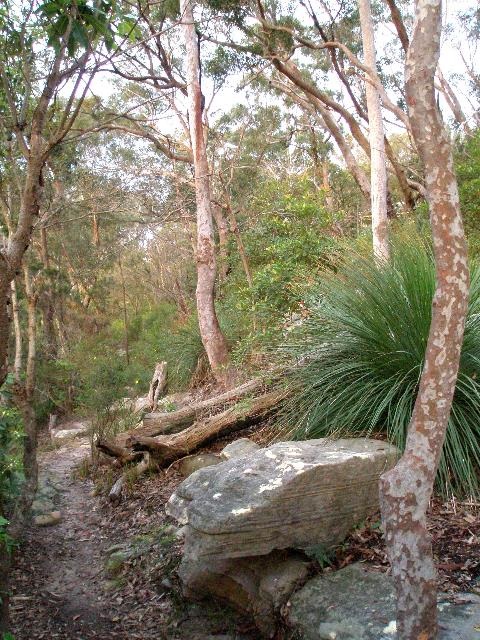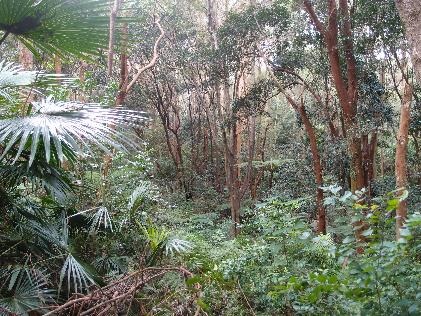Native Vegetation

Lane Cove bushland offers a diverse array of flora and fauna. Around 625 species of indigenous plants have been recorded, among them a number of vegetation types such as wet and dry sclerophyll forest, heath land, mangroves and tidal flats.
Walking through various bush tracks will display the fascinating progression of vegetation zones from tall blue gums and turpentines to the succulent groundcovers growing in the saltmarsh at the river estuary.
More detailed information about vegetation communities in Lane Cove can be found in the following reports:
Endangered Ecological Communities
Six vegetation communities found in Lane Cove are listed as Endangered Ecological Communities under the Biodiversity Conservation Act 2016. These are:
- Coastal Saltmarsh (also referred to as Estuarine Saltmarsh)
- Estuarine Swamp Oak Forest
- Coastal Freshwater Swamp Forest
- Coastal Escarpment Littoral Rainforest
- Blue Gum High Forest
- Sydney Turpentine Ironbark Forest
Lane Cove is also home to an endangered Hygrocybeae fungi community.
Two communities - Blue Gum High Forest and Sydney Turpentine Ironbark Forest - are listed as Critically Endangered Ecological communities under the Commonwealth Environmental Protection and Biodiversity Conservation Act 1999.
Coastal Saltmarsh
Coastal Saltmarsh is an Endangered Ecological Community found along the Lane Cove Estuary. It occurs in the intertidal zone on the shores of estuaries and lagoons that are permanently or intermittently open to the sea. In Lane Cove, this vegetation is frequently found on the landward side of mangrove stands, though mangroves can occasionally be found scattered through saltmarsh areas. To find out more about saltmarsh along the Lane Cove Estuary, refer to the reports and maps below.
Estuarine Swamp Oak Forest
Occurs on the fringe of the Lane Cove River Estuary, normally slightly above the tidal inundation zone. There are several remnant patches totalling 3.7ha. It typically forms a band between Coastal Saltmarsh or Mangrove Forest and terrestrial vegetation communities.
Coastal Freshwater Swamp Forest
Occurs on a small and low lying plain, slightly above the tidal inundation area. It is subject to waterlogging from fresh to slightly saline water. Only one small remnant of 0.3ha occurs in the Lane Cove Local Government Area.
Coastal Escarpment Littoral Rainforest
Occurs along the riparian zone of almost all creeks in the Lane Cove area totalling 7ha generally on clay soils derived from shale layers. The majority of Lane Cove sites possess a tall schlerophyll canopy with at least one of the following species: Blue Gum, Blackbutt and/or Turpentine. As such this community is closely aligned to Blue Gum High Forest and Sydney Turpentine Ironbark Forest.

Blue Gum High Forest
 Occurs in just 2 locations totalling 1.2ha. This vegetation community would have once covered considerable areas of the now urbanised shale caps. There is less than five percent of the original Blue Gum High Forest left in the Sydney basin bioregion and it is listed as critically endangered under Commonwealth law to help prevent further decline.
Occurs in just 2 locations totalling 1.2ha. This vegetation community would have once covered considerable areas of the now urbanised shale caps. There is less than five percent of the original Blue Gum High Forest left in the Sydney basin bioregion and it is listed as critically endangered under Commonwealth law to help prevent further decline.
Typical threats to this vegetation community in the Lane Cove LGA are urban run-off (which leads to increased nutrients and sedimentation), weed invasion, and inappropriate fire regimes (which have altered the appropriate floristic and structural diversity).
Best Practice Guidelines for Blue Gum High Forest
Sydney Turpentine Ironbark Forest
 Only small areas remain totalling 6.3ha on the edges of Blue Gum High Forest, Coastal Escarpment Littoral Rainforest and Coastal Enriched Sandstone Forest. It is also listed under Commonwealth law as being critically endangered and suffers similar threats to Blue Gum High Forest.
Only small areas remain totalling 6.3ha on the edges of Blue Gum High Forest, Coastal Escarpment Littoral Rainforest and Coastal Enriched Sandstone Forest. It is also listed under Commonwealth law as being critically endangered and suffers similar threats to Blue Gum High Forest.
Best Practice Guidelines for Sydney Turpentine Ironbark Forest